The Most Popular Types of Koi Fish for Your Pond
May 12th 2025

May 12th 2025

Koi ponds aren’t merely aesthetic features for backyards—they are intricate and complex underwater ecosystems. The heart of these ponds, however, is the koi. Koi bring life and vibrance to a simple pond with their unique charm, personality, and color dynamics, turning it into a dazzling display of aquatic beauty.
It's truly spellbinding how koi swim in their pond, displaying their eye-catching colors and patterns underwater. Collectively viewed, they are striking, but taken individually, each holds centuries of cultural significance and distinct selective breeding. Koi supply a new vibrancy and energy to any pond, either achieving balance and purpose for a current collection or serving as colorful and playful stock for a newly constructed one.
Identifying the most common breeds of koi fish is what we will explore next. Spanning from blending different organisms cohesively to ensuring a lifestyle is in place to maintain the health alongside the pond's beauty.

Judging by what we know so far, it is safe to say that Kohaku would rule the kingdom… if koi had sages or royal advisors. Known as the oldest and foundational variety, Kohaku marks the peak of elegance of koi. Their white bodies, marked with eye-catching red, are as exquisite as they come; so Kohaku is the benchmark against which many other koi are judged.
The red patterns, called “hi,” are along the stripe and should be well-defined against the white base. A Kohaku's appeal is accentuated by the sharp edges of its markings, or “kiwa.” Because of simplicity, they are difficult to turn away from; there’s nowhere for flaws to hide.
Kohaku’s timeless appearance soars their reputation as the foundational essence of koi, with which every other fish is compared. Whether you are a beginner setting up a pond or entering koi competitions, Kohaku offers heritage and beautiful waters.
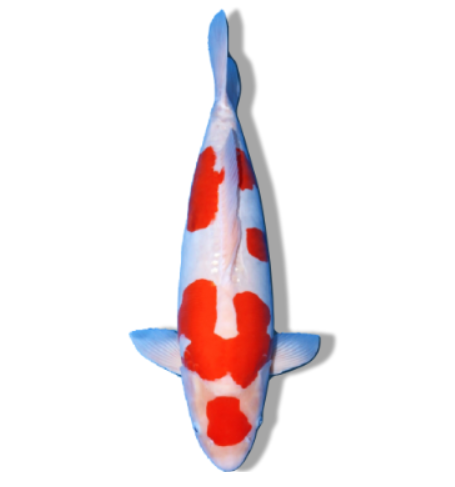
Textures rather than colors define Doitsu koi. Unlike the other koi, they traditionally do not have full-body scales but a sleek body with one or two large reflective scales at the front that run along the spine.
A Doitsu variety can be anything: Doitsu Showa, Doitsu Kohaku, etc.
Because of the lack of scales, colors and patterns are sharper and more precise. Every pond needs an attractive, yet different, addition.
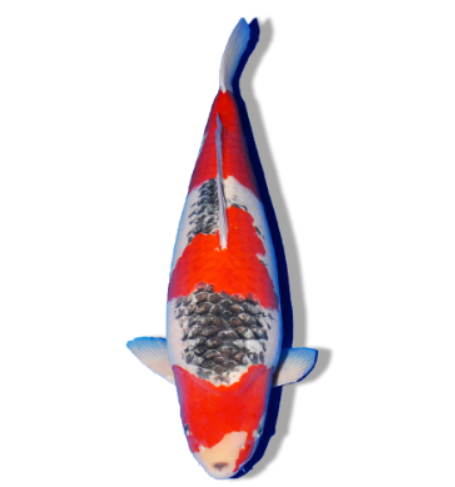
These are also very durable and appropriate for anyone new to keeping koi. Goshiki translates to "five colors" and is often described as being painted. With an underlay of dark blue or black, Goshiki koi sports an array of red, white, grey, and blue.
Like Kohaku, young Goshiki exhibit a peculiar resemblance; however, their base color darkens as they age, and their patterns become more intricate. Their beauty is completely unpredictable—Shioyama is not the same as the other.
Koi enthusiasts who love a bit of mystery alongside variety will enjoy Goshiki.
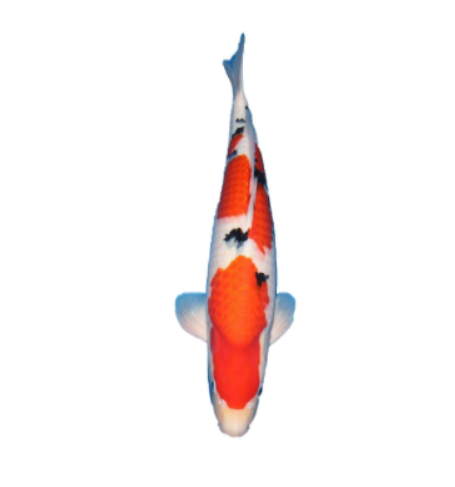
Commonly referred to as “Sanke,” this variety uses Kohaku’s color base. It adds elegantly refined black markings "sumi" across the body, resulting in a tri-colored koi that balances red, black, and white into harmonious patterns.
Originating during the Taisho era in Japan, the Taisho Sanke’s ideal pattern avoids fumigating sumi on the head and concentrates it instead on body placement. This enhances the head to elegantly retain the simplicity of a Kohaku while simultaneously striking black contrasts on the body.
Sanke is a household name among hobbyists and competitive koi fans. They are exceptionally adaptable, stunning, and offer a sinful degree of complexity to mixed ponds.
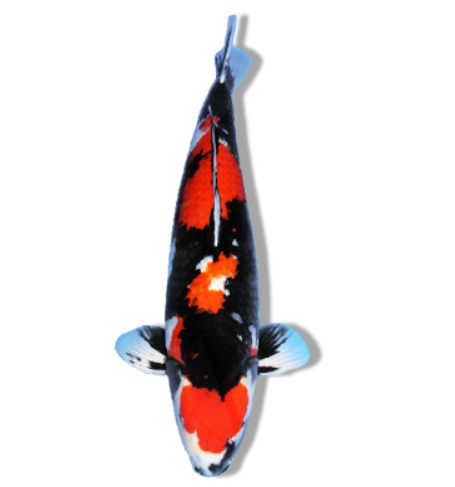
Where Sanke adds black to a red-and-white koi, Showa Sanshoku starts with black as the base and layers red and white on top. This fundamental difference gives Showa a richer, more dynamic presence.
Showa has black patterns on the head, distinguishing it from Sanke. They appear dramatic and intense during rest, with the body wrapped in sumi, creating a striking, bold ink look.
These koi also get sharper contrast as they age, and their patterns become more intricate over time, making them a favorite for long-term koi customers.
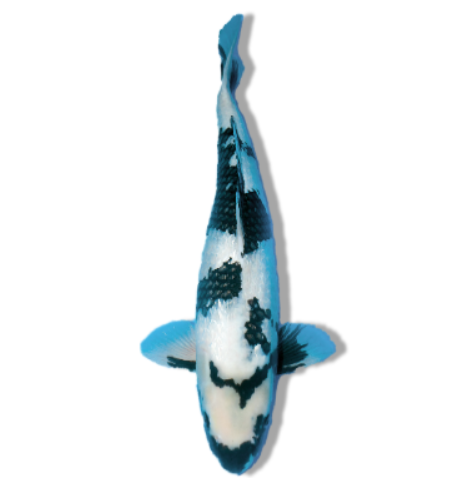
Utsurimono koi, or simply “Utsuri,” is another black-based koi class with a clean and bold contrast.
The three main types include:
The checker-like structuring, colored base differentiated with top colored layer placement, is what forms on these koi. These have a greyish black upper part of their body, so the head and the rest need complete order to form a balance on which a premium and unique Utsuri is based.
The sharp tiger outline spaces them, allowing them to be put in ponds where striking variance is required. With bright water, they look like little skin lanterns.
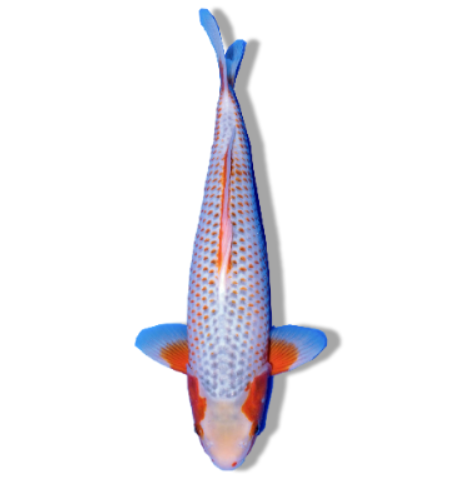
Asagi possesses some of the most ancient features of the koi family. The intricate patterns of their scales enhance their deep calmness. Their backs are covered with light blue netting, and their cheeks, bellies, and fins are red or orange.
What makes Asagi special is its consistency and subtle elegance. Although they lack brightness, they are incredibly soothing to watch. Their blue colors change slightly depending on the lighting and depth, which is relatively calm yet gentle.
Widely known as classics, Asagi are the pride of traditionalists and are suitable for ponds designed in a Japanese or naturalistic style.
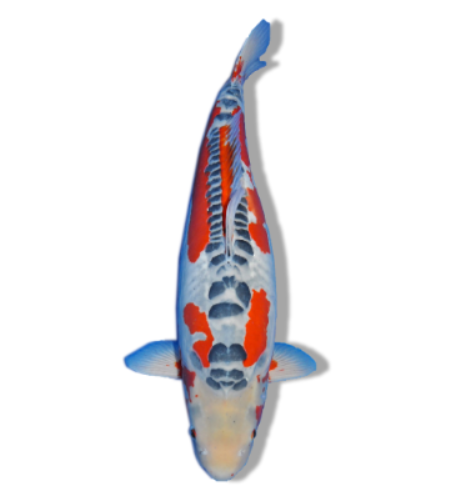
Shusui koi are the Doitsu (scaleless) version of Asagi. Instead of full-body scaling, they have a smooth body with a single row of large, mirror-like scales along the spine.
Compared to Asagi, their colors are much brighter, with the sides being a deep red and their backs bright blue. This is due to the lack of scales, allowing for greater clarity of vibrant colors.
If you are looking for sleeker and more modern fish than the Asagi, the Shusui are perfect.
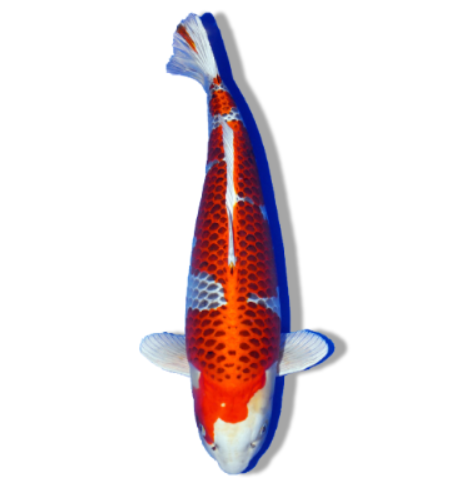
Kujaku means "peacock," and this name suits these koi well. These koi have a white body with reticulated black net patterns and red or orange marks. This koi is a member of the Hikari Moyo class that is known for their metallic sheen and multicolored beauty.
The metallic luster brings the netting’s depth and textures to life, making it sparkle in sunlight. Koi are among the most visually diverse koi types.
Kujaku koi bring detail to ponds that contain neighbors with gentler patterns.

Odon are described as solid-colored metallic koi because they come in one color and shine like polished metals under the water.
The most popular types include:
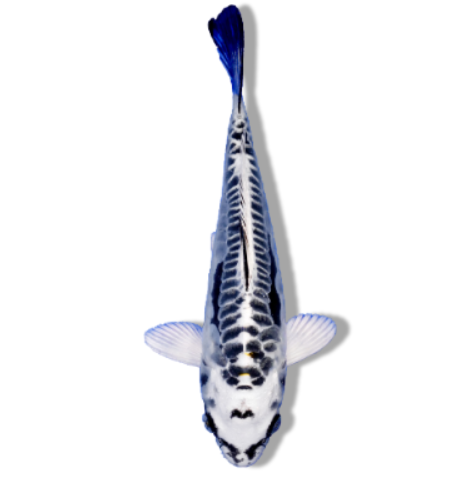
Depending on water temperature and age, Kikokuryu koi are metallic, scaleless koi that undergo color changes. They possess black and white colors that are accented with shiny borders.
Kin Kikokuryu adds gold tones to the same reflective effect. Their dramatic, ever-changing appearance makes them popular with koi enthusiasts looking for show-stopping variety.
To intensify their shine, they can be kept in ponds with direct sunlight, allowing them to steal the show truly.
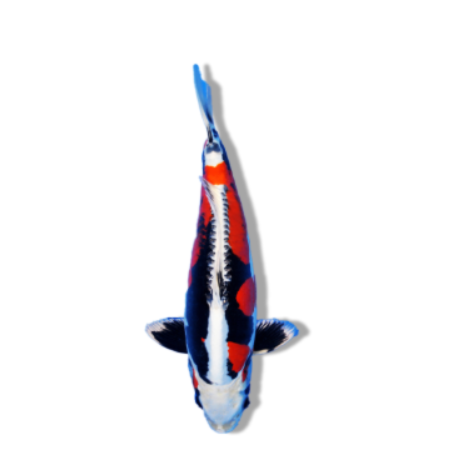
Beni Kikokuryu koi are metallic, mostly scaleless beauties with bold red or orange markings and shifting black sumi patterns. Their platinum-white base gleams in sunlight, making them true standouts in any pond.
A mix of Kikokuryu and Kohaku lines, they balance stability with surprise — the beni stays bold while the sumi evolves. This ever-changing contrast keeps collectors coming back for more.
Best displayed in outdoor ponds with plenty of light, Beni Kikokuryu bring sharp color, shine, and a striking presence that never feels static.
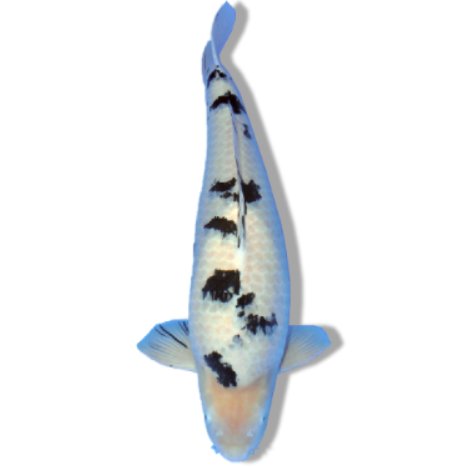
Bekko koi are characterized by their one-color base (white, red, or yellow) with minor black markings.
They come in three varieties:
Though they may lack detail, their appeal overshadows the less intricate design. Sumi markings are toned towards brighter and more dramatic koi, offering a more peaceful, harmonious look.
Especially for ponds showcasing intricate patterns, Bekko is excellent for novices and seasoned koi keepers.
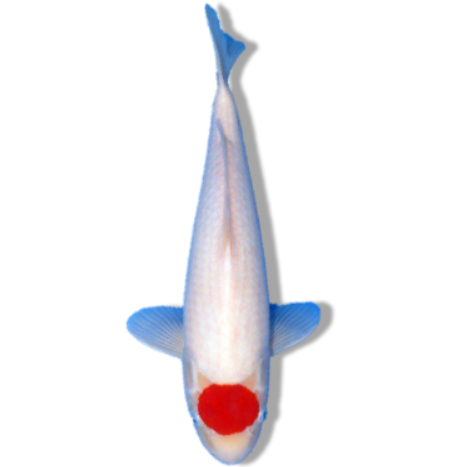
With a bold white figure and a single red circle at the head, Tancho koi are highly distinguishable. Their resemblance to the Japanese flag gives them symbolic importance, as they represent purity, simplicity, and national pride.
The body does not contain any other red, which enhances the statement as they become a focal point in any pond.
Kohaku, Sanke, and Showa Tancho varieties exist where the head spot is the defining characteristic.
Most new keepers will find Yamabuki Ogon and Kohaku easy to manage. They are beautiful and simpler to care for than the finely detailed patterned varieties, which makes them more sturdy.
Of course, koi are very social and peaceful, and thrive in a community setting. Just be sure to have an adequately sized pond with quality filtration and introduce new koi slowly to minimize stress.
A good benchmark would be one koi per 250 gallons of water. Allowing your koi room to grow avoids overcrowding and helps maintain healthy water quality.
No, they don’t. Koi will continue to grow regardless of the size of the pond, which makes proper planning crucial. Some can reach up to 36 inches, so always consider their adult size when stocking.
Find stunning koi hand-selected from renowned breeders, chosen for their vibrant colors and unique patterns—only at Fitz’s Fish Ponds. Whether you're starting fresh or expanding your collection, our expert team is here to guide you every step of the way. From initial selection to pond planning, we’ll help turn your vision into a thriving, show-worthy reality.
Call us at (908) 360-1979, ask one of Our Experts, stop by an FFP Retail Store Near You, or shop online. Your perfect koi pond starts here!
| Hours | |
|---|---|
| sunday | Closed |
| monday | Closed |
| tuesday | 10:00-5:00 |
| wednesday | 10:00-5:00 |
| thursday | 10:00-5:00 |
| friday | 10:00-5:00 |
| saturday | 10:00-5:00 |
| Hours | |
|---|---|
| sunday | 10:00-5:00 |
| monday | Closed |
| tuesday | 11:00-6:00 |
| wednesday | 11:00-6:00 |
| thursday | 11:00-6:00 |
| friday | 11:00-6:00 |
| saturday | 10:00-5:00 |
| Hours | |
|---|---|
| sunday | 10:00-4:00 |
| monday | Closed |
| tuesday | 10:00-5:00 |
| wednesday | 10:00-5:00 |
| thursday | 10:00-5:00 |
| friday | 10:00-5:00 |
| saturday | 10:00-5:00 |
| Hours | |
|---|---|
| sunday | 10:00-5:00 |
| monday | Closed |
| tuesday | 11:00-6:00 |
| wednesday | 11:00-6:00 |
| thursday | 11:00-6:00 |
| friday | 11:00-6:00 |
| saturday | 10:00-5:00 |
| Hours | |
|---|---|
| sunday | Closed |
| monday | 9:00-5:00 |
| tuesday | 9:00-5:00 |
| wednesday | 9:00-5:00 |
| thursday | 9:00-5:00 |
| friday | 9:00-5:00 |
| saturday | Closed |
| Hours | |
|---|---|
| sunday | 10:00-4:00 |
| monday | Closed |
| tuesday | 10:00-5:00 |
| wednesday | 10:00-5:00 |
| thursday | 10:00-5:00 |
| friday | 10:00-5:00 |
| saturday | 10:00-5:00 |
| Hours | |
|---|---|
| sunday | Closed |
| monday | Closed |
| tuesday | 10:00-5:00 |
| wednesday | 10:00-5:00 |
| thursday | 10:00-5:00 |
| friday | 10:00-5:00 |
| saturday | 10:00-5:00 |
| Hours | |
|---|---|
| Sunday | Closed |
| Monday | Closed |
| Tuesday | 10:00-5:00 |
| Wednesday | 10:00-5:00 |
| Thursday | 10:00-5:00 |
| Friday | 10:00-5:00 |
| Saturday | 10:00-5:00 |
| Hours | |
|---|---|
| Sunday | 10:00-4:00 |
| Monday | Closed |
| Tuesday | 10:00-5:00 |
| Wednesday | 10:00-5:00 |
| Thursday | 10:00-5:00 |
| Friday | 10:00-5:00 |
| Saturday | 10:00-5:00 |









| Hours | |
|---|---|
| sunday | Closed |
| monday | Closed |
| tuesday | 10:00-5:00 |
| wednesday | 10:00-5:00 |
| thursday | 10:00-5:00 |
| friday | 10:00-5:00 |
| saturday | 10:00-5:00 |
| Hours | |
|---|---|
| sunday | 10:00-5:00 |
| monday | Closed |
| tuesday | 11:00-6:00 |
| wednesday | 11:00-6:00 |
| thursday | 11:00-6:00 |
| friday | 11:00-6:00 |
| saturday | 10:00-5:00 |
| Hours | |
|---|---|
| sunday | 10:00-4:00 |
| monday | Closed |
| tuesday | 10:00-5:00 |
| wednesday | 10:00-5:00 |
| thursday | 10:00-5:00 |
| friday | 10:00-5:00 |
| saturday | 10:00-5:00 |
| Hours | |
|---|---|
| sunday | 10:00-5:00 |
| monday | Closed |
| tuesday | 11:00-6:00 |
| wednesday | 11:00-6:00 |
| thursday | 11:00-6:00 |
| friday | 11:00-6:00 |
| saturday | 10:00-5:00 |
| Hours | |
|---|---|
| sunday | Closed |
| monday | 9:00-5:00 |
| tuesday | 9:00-5:00 |
| wednesday | 9:00-5:00 |
| thursday | 9:00-5:00 |
| friday | 9:00-5:00 |
| saturday | Closed |
| Hours | |
|---|---|
| sunday | 10:00-4:00 |
| monday | Closed |
| tuesday | 10:00-5:00 |
| wednesday | 10:00-5:00 |
| thursday | 10:00-5:00 |
| friday | 10:00-5:00 |
| saturday | 10:00-5:00 |
| Hours | |
|---|---|
| sunday | Closed |
| monday | Closed |
| tuesday | 10:00-5:00 |
| wednesday | 10:00-5:00 |
| thursday | 10:00-5:00 |
| friday | 10:00-5:00 |
| saturday | 10:00-5:00 |
| Hours | |
|---|---|
| Sunday | Closed |
| Monday | Closed |
| Tuesday | 10:00-5:00 |
| Wednesday | 10:00-5:00 |
| Thursday | 10:00-5:00 |
| Friday | 10:00-5:00 |
| Saturday | 10:00-5:00 |
| Hours | |
|---|---|
| Sunday | 10:00-4:00 |
| Monday | Closed |
| Tuesday | 10:00-5:00 |
| Wednesday | 10:00-5:00 |
| Thursday | 10:00-5:00 |
| Friday | 10:00-5:00 |
| Saturday | 10:00-5:00 |
